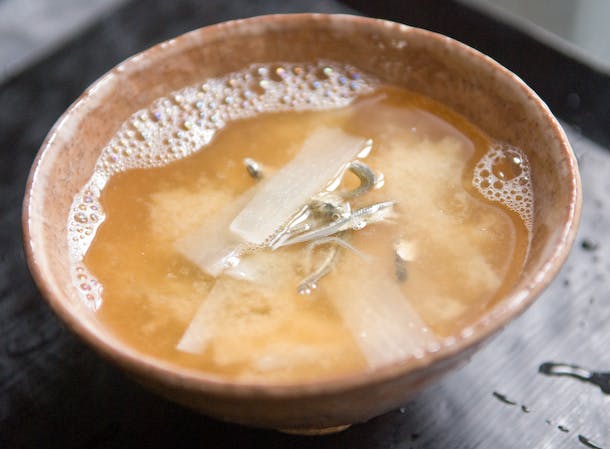
Iriko Dashi & Daikon Miso Soup
Learn how to make a traditional Japanese miso soup using iriko dashi, a simple broth made from small dried fish. This recipe includes the technique for preparing iriko dashi and the ingredients and steps for making the miso soup. Discover the unique flavors and pairings of iriko dashi in traditional Japanese cooking.
First, let's talk about iriko dashi, a traditional dashi prepared from small dried fish. While konbu and katsuobushi dashi is intricate and involved, iriko dashi is the opposite: Totally simple to make. Iriko, the fish, come in a variety of sizes, but Atsushi chose the smallest available, about an inch or so long. He used the entire iriko, explaining that while some chefs say to break off the head and stomach, he and his father don't agree with that. "It's more natural to use the entire iriko," Atsushi explained, adding that the head holds a lot of flavor. To prepare the broth simply bring iriko and water to a boil. I used about a tablespoon of iriko to two cups of water. As soon as you can smell the fragrance of the iriko, the dashi is ready. You can either strain out the iriko, or leave them in to eat in soup.
By the way, I asked Chef Ono about iriko dashi and he mentioned a couple of interesting things: Iriko dashi does not create the umami a konbu and katsuobushi dashi does, so it's not used for infusing other ingredients. But it pairs extremely well with miso, so it typically serves as the foundation for miso soup.
On to the miso soup. The ingredients:
- Iriko dashi
- Awase miso (a mixture of red and white miso, which is mellower and perfect for soup)
- Daikon
The technique: Cut the daikon into thin rectangular strips, a cut called "tanzaku" in Japanese. I used a fresh daikon from the farmers market, which I peeled. You can add the peel to the iriko and water when you make the dashi. Prepare the dashi, as discussed above. I left the iriko in the dashi but removed the daikon skin. Add the cut daikon and simmer until it just cooks through. Turn off the heat and add the miso with a strainer. Taste often until you have the right flavor -- the miso shouldn't overpower. Serve and enjoy.
